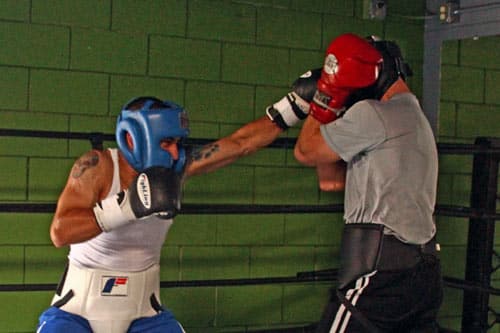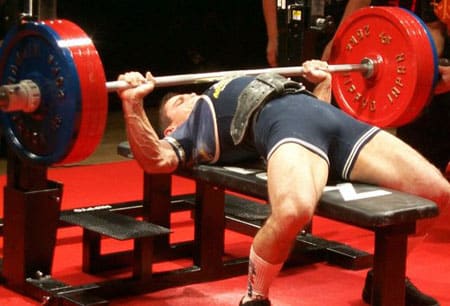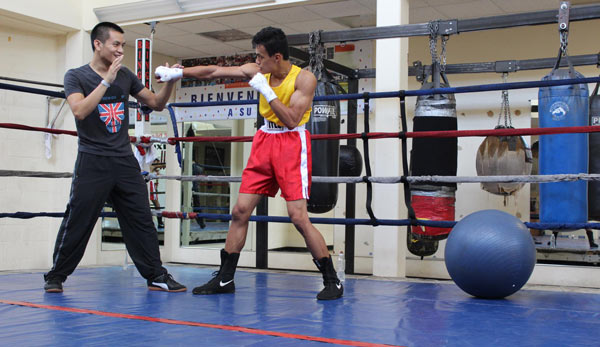
If there was ever a boxing combination to be labelled the best, this would be it. It is so simple yet so deadly when you learn all the variants of the old “jab-jab-cross”. Many trainers told me over and over the 1-1-2 is boxing’s bread and butter combo, better than any other punch combo but I couldn’t understand why. Throwing double jabs in the ring only guaranteed that I would be eating more right hand counters and so I got scared of throwing them.
Many years later, I finally realized what my trainers REALLY meant.
This is how you throw a REAL jab-jab-cross combination…
The 1-1-2 is the most versatile boxing combination!
The double-jab, cross combination is the most versatile boxing combination there ever was. It’s so powerful and so tricky, you could use it over and over and never get countered. When I first started boxing, every trainer told me THIS was the punch combination to master. They all said the 1-1-2 could beat any opponent. Not the 1-2 (jab-cross), not the 1-2-1-2 (jab-cross-jab-cross), or the 1-2-3 (jab-cross-hook)—they all said the 1-1-2 was the golden combination.
Being a beginner, I wasn’t wise enough to understand the advice. Throwing a double-jab was not only tiring out my front hand (a common problem for beginners), it got me countered. I tried listening to my trainers but it didn’t work. A pitty-pat double-jab didn’t get any of my opponents’ respect. They all walked through my jabs or slipped and easily countered me. It wasn’t long before I got anxious to throw my power hand as soon as possible.
But then I fought a pro one day….and OHHHHHH, so THAT’S HOW YOU DO IT! This guy absolutely terrorized me with the 1-1-2. His double-jabs were throwing me off balance, touching me and bothering me from every angle. And right when I got distracted for even a SPLIT SECOND, I paid the ultimate price when his right hand came. In just 9 minutes, I learned the secret to the 1-1-2 that my trainers had tried to teach me for months!
The secret to the JAB-JAB-CROSS,
is in the variation of the jabs!
Watch my video demonstration to see how I throw different jab-jab-cross combinations.
Change the Rhythm (speed vs power)
HARD-HARD-HARD
This is probably the first and most natural way any boxer ever learned how to string a combo together. The typical beginner doesn’t know how to make a combo more effective other than to increase power. Well, it works. A hard 1-1-2 will definitely get anybody’s attention. It’s good to work on to make sure you’ve got that sharp power and commitment behind those punches.
The problem with this HARD-HARD-HARD rhythm is that it’s too slow and too predictable. At the higher levels of fighting, you’ll need to mix in faster jabs to create openings for your hard shots. Once you’re done throwing that same boring JAB-JAB-CROSS combo over and over, we can move on to the more interesting variations.
fast-fast-HARD
This one is beautiful. Follow someone around the ring with a bunch of pitty pat jabs and then hammer him with a huge right cross. It’s so easy to do; you can throw endless jabs while waiting for your right hand. And since you’re throwing a bunch of speedy non-committed jabs, you can fling them all over the place–his head, his elbows, gloves, shoulders, etc. You’ll naturally aim everywhere you can to distract him for your right hand.
The problem with throwing only pitty pat jabs is that he can counter you with harder punches. Once he catches on to your tricks, he’s going to walk through your light jabs and counter hard. In the time that you throw 2 fast jabs, he might throw a hard jab to disrupt you and then a hard right to hurt you. We’ll have to mix in hard and fast jabs to be even trickier!
HARD-fast-HARD
This is a great rhythm to catch opponents off guard. Throw a HARD jab, followed by a fast jab, then a big right cross. An easier way to visualize this would be to throw a JAB-oneTWO! So it’s like a big jab gets his attention, and then you immediately go into a fast one-two combination. A faster second jab is used so you big right hand can get there sooner. A faster second jab also has the strategic benefit of arriving sooner than he expected and potentially disrupting his counter.
You can make the second jab faster by not retracting your hand all the way after the first jab. Pull it back only a few inches after the first jab and then release it forward again. Another way to think of it is JAB-touch-RIGHT!
fast-HARD-HARD
This is an incredibly tricky rhythm and will open up many strategic possibilities for you later. PLEASE LEARN THIS ONE–it’s a game-changer! This time around you start off with a fast jab, then followed by a hard 1-2. The first jab distracts, the second jab penetrates straight in and the cross is the finishing blow.
Later, you will use the first quick jab to punch at a random place to make your opponents block there and exposing himself elsewhere for your 1-2.
feint-HARD-HARD
Once you get the hang of the fast-HARD-HARD rhythm, you’ll want to be faster with the first jab. The faster the first jab, the easier you can land the 1-2. Naturally, you’ll realize the first jab doesn’t even have to be a real jab–it can be a feint. And there you go, use the fast-HARD-HARD rhythm but throw a feint instead of a real jab as the first punch. A fast jab doesn’t cause much damage anyway, so why not use a feint instead which is so much faster and doesn’t leave you as vulnerable.
Change the Aim
The easiest way to make your combinations more tricky is to aim at different places. And there are FARRRR more places on the body than you think. Most boxers I see only know how to throw at the head or body. Believe me, there are far more places than that. Learn how to target different places and take advantage of your opponent’s reactions to your different movements. And the only way to do this is to try aiming at different places.
First priority of a punch: cause damage.
Second priority of a punch: cause a reaction.
Head
Are you aiming (high) at the forehead? Or (low) at the chin? Straight on at the face (into the nose) or into the side (cheeks)? What about the side of his head by the ear? Often times your opponent may leave the top of his head or the side of his head open. Other times opponents will cover their heads by lifting their gloves too high and exposing their body.
Body
The body is full of many angles of attack ESPECIALLY when the opponent is punching. You can aim at so many areas of the body from the front or the sides. Tactically, you can aim at different parts of your opponent’s body to draw his gloves down and expose his head.
Arms
The arms are a great tactical place to attack. Punching or pushing the shoulders can make your opponents lean back off balance. Punching at their gloves can distract them or make them cautious of countering in fear of exposing themselves, allowing you to land punches elsewhere.
Air
Punching at the air around your opponent can sometimes cause him to react by swiping at your feints, or leaning off balance, and/or otherwise expose himself. I especially love to throw feints at the air. Even a simple lift of my right glove can cause a reaction.
Change the Punches
Changing the right hand is easy and quite natural. Instead of a right cross, use an overhand right or maybe a right uppercut, or try a really straight right hand up the middle. It’s simply a matter of bending or unbending the elbow and then letting the punch come from higher or lower. Sometimes wider, sometimes straighter.
Now swapping the jabs for something else is where the REAL trickery comes in. Once you learn this, it will change your 1-1-2’s FOREVER! Pay close attention to this part of the boxing guide. All you have to do is replace one of your jabs for a left hook or left uppercut.
Switching the first punch for a hook or uppercut
Now your combo becomes a 3-1-2 or 5-1-2. You are switching the first jab for a left hook or left uppercut. This tiny little change alone CAN DESTROY YOUR OPPONENT! The reason why it’s so deadly is because the hook or uppercut angle will really distract your opponent and make it easier for you to land the follow-up 1-2.
The key is to throw the left hook/uppercut like a jab
It has to feel like a jab, same level of power, same attitude. Don’t pivot, don’t try to make it a real hook. Make it a quick slap hook as if you’re just slapping him on the side to make his guard shift over and then hit him with a hard 1-2 straight up the middle. Same thing if you’re using the uppercut. Make it a really long straight jab but with the palm facing up. What looks like a simple straight jab but with a reverse rotation will make your opponent FEEL like he’s getting hit by a different punch. When throwing the 5-1-2, you can use that upside down jab to tip his chin up (a quick surprise), then penetrate with a straight jab, then follow with a hard right.
All you need is for him to feel something different
and that will be enough for you to trick him.
The 3-1-2’s and 5-1-2’s are my absolute favorite trick combinations. It’s like a quick slap, then 1-2! Or a quick touch on the elbow, then 1-2! So easy, so fast, and so damn tricky to defend because the angles are so unexpected. THROW IT LIKE A 1-1-2. (And yes, you should try altering the rhythms as well; not only the punches. Faster is better.)
Switching the second jab for a hook or uppercut
Ok, now you’re throwing a 1-3-2 or 1-5-2. Again, the hook or uppercut has to be thrown like a jab. Your opponent will feel like they’re angled punches but YOU have to throw them as though you were throwing a 1-1-2. The same rules above will apply here. Don’t worry about the pivoting or adding power to the hook/uppercut, simply extend your arm as though you’re throwing a jab but rotating the fist so it comes from the side (hook) or from the bottom (uppercut).
Using the hook/uppercut as the second punch will quickly divert your opponent’s defense because nobody likes to get hit from the hook or uppercut angle. Fighters are usually psychologically pre-conditioned over the years to think of those angles as power punches and not soft punches. Exploiting these fast hooks and fast uppercuts will definitely confuse your opponent long enough for you to land the right hand.
Changing the Angle
Now the only thing left is to change your punching angle. You can do all the same trickery (altering the rhythm, aim, punches) but now while changing your body angle.
Neutral Angle
Coming in straight up from your boxing stance. It works and it’s a good place to start for beginners. I suggest you practice the 1-1-2 from the neutral angle before venturing beyond! Fighters that learn to change the angle too early lose their balance/power because they over-do it.
Forward Angle
Throw the 1-1-2 while coming forward (or circling). Or throw the first two jabs from the neutral angle, but then come forward with your right hand. It can be a slight tilt forward or a slight tilt forward and to the side. It can create a new angle for you to attack with the right AND/OR help avoid your opponent’s counter. A slight lean is all you need to make use of this sudden change of angle.
Back Angle
Throw the first two jabs while retreating, and then come back with your right hand. Or throw the first two jabs while coming in, and then lean away as you dig a wide right uppercut into your opponent’s counter.
The “pro’s combo”: the jab-jab-right
The purpose of the first punch,
is to set up your other punches.
If you haven’t already figured out by now, the first punch of the 1-1-2 combination is typically meant as a distractor. Almost nobody gets hit by the first punch. So the goal is to make the first punch as tricky as possible to create openings for the real 1-2. The more skilled your opponent, the more you realize the effectiveness of your first punch comes from trickery, NOT power. And then once you mix in different rhythms, targets, punches, angles, AND footwork–IT’S GAME OVER FOR YOUR OPPONENT!
The most dangerous combination in boxing, the double-jab, right hand!
Who would have known that stringing together just 3 simple punches could be so deadly? Realizing what I could do with the simple jab-jab-cross was probably one of the greatest discoveries of my life. Not only was I fighting better but it helped me understand what was going on inside the world of professional fighting. You often see a fighter getting hit with what looks like a simple combination and you can’t understand why.
Well now you know: it’s because the other guy is switching up the rhythm, punches, and angles. He’s making it feel like a regular 1-1-2 but it’s actually something else. And sometimes, it IS a 1-1-2 but he made it FEEL like something else. HOW CONFUSING!
You can apply everything you learned here to other combos, not only the 1-1-2!
It’s not the punches you throw,
It’s HOW you throw them.










I love you and your articles
Sir,
I have been reading your articles for a while now, multiple times over. This is a first time post for me! I usually just keep quiet and read the articles and comments (i love to observe and absorb). I feel this article has forced me to comment after reading because i cannot keep quiet after reading it. Pure gold mine! I refer to this website as my “bible” for boxing, everything from beginner to advanced level. This 1-1-2 combination peice is written very well and enables the reader to get a great visualization! I cant wait to incorporate the techniques and stragety into my training, definitely something i aim to master and bring my combat abilities to the next level!
Johnny,
Just to echo the above — been soaking up your site for about a month now, and its really helped my understanding and approach to boxing.
Last weekend i spent the whole time shadowboxing and on the bags doing “two-legged punching” after realizing i am totally guilty of sticking my butt out too far. It was awesome! didn’t realize how easy i was going on my legs before!!
Same goes for this 1-1-2, it makes so much sense, and for some deadly combos! Really well written, and super helpful! I look forward to upping my tricknology and power in fights to come..
I often thought a stream of stright punches was for chacing a opponent down to land further shorter punches close up? Correct me if I am wrong.
Oh yeah and by the way I have watched your viedoes on the right corss and stratergy as well as the artical on jabbing before and I have to say I think their the bee’s knee’s, keep up the good work and by the way when’s the next body punching artical coming up?
Your first question is about strategy. It doesn’t matter what you do as long as it works. There’s no rule saying that straight punches can only be used for one purpose. The next body punching article won’t be ready for a little while.
What is the most proficent way for me to wear out my opponent with body shots should i aim for the liver or the pit of the stomoch first or should i start up top then work my way down?
Whichever way you can do it. There is no set rule because all opponents are different.
Johnny, I am a HUGE fan of your page and I thank you for your constant effort. In regards to this particular posting, does the 1-1-2 theory remain the same for a southpaw facing an orthodox boxer?
You’re welcome and yes, the 1-1-2 remains the same no matter what.
Quick question. What is the best way in general to get around this tactic if you find yourself in a situation where your opponent is using this tactic against you? Would it be a better risk to try and focus on countering the tricky jabbing hand or to wait and counter the power hand?
It depends on what he’s doing. If he’s using rhythm, then I interrupt his rhythm. If he’s using angles, I cut off those angles. If he’s using punches, I start using the counter for those counters. My game is to counter small punches with small punches and counter bigger punches with big punches.
Thanks for the tips! Greatly appreciated! Gotta make sure i work on this. My sparring partner is much better than me in pretty much all areas (technique, experience, endurance, footwork, power etc…). I realize this 1-1-2 variation is what he uses against me most of the time and its really difficult for me to handle. I will pay extra attention and focus on my awareness and timing training so i can have a better shot dealing with him and countering effectively. I am a firm believer that one learns more from sparring a higher skilled fighter than a lesser skilled opponent. So yeah, i pretty much get beat up lol, but i get closer and closer everytime!
Oh yeah and once again. Awesome site johnny! Keep up the good work and never stop fighting!!
Thanks for sharing an amazing article. I learn som much it’s fun in the gym once I apply my knew found knowledge.
“Simplicity is the ultimate sophistication” ~ Leonardo da Vinci
Keep up the GREAT work bro!
Amazingly eye-opening article, J! The 2nd best combo is the jab-jab-donkey punch.
The intro to this guide was like straight out from my keyboard.
Good stuff.
This combination once startled me in an amatuer tournament in East London. When the second jab comes you fill like your opponent is saying, “so you think you can block my jab, watch this” boom! It is too good it hurts. So how do you counter attach and when? I think moving out of its way helps diminish its desired objective. Either down or sideways.
It all depends on what he’s doing. There’s no easy way to answer this if he’s switching up so many factors (rhythm/angles/punches/etc).
Very good and comprehensive article. I’m going to try some of the combinations.
I found that 1-1-1-2 is very surprising as well. No one I played against didn’t expect the third jab and then the cross.
Yeaup! And then the game evolves into 1-1-1-1-1-1-1-1 with both guys flicking non-stop jabs. 😉
Johnny ,
I have a hard time committing to combinations when sparring. I tend to be a comfortable counter puncher, but struggle to land multiple strikes after the first one. When I do use combinations, I find it difficult to land the second/third punch because my opponent has defended and moved out of range. I have a pretty good handspeed and quick feet so I would think I could use punching combos to my advantage. I know being able to throw combinations is the next step in my development Does any one have advice on staying in range when throwing combinations?
Thank you
It’s hard to throw combinations when your opponent is going away. So you have to find a way to attack when he’s coming in. And also learn how to trap him. And/or it sounds like your combinations might not be fast enough. Or you are punching too early. If you punch when your opponent is barely in range, he’ll always fall outside of your reach. But if you let him get deep into your range, you can blast him with multiple shots.
Thanks Johnny!
Once again, your advice is brilliant. Everyone always tells me to use my double jab but I always get smacked in the nose when I do it. Watching the video helps a lot. I can’t wait to practice the double jab cross in the gym.
Cheers,
Monica
Can’t wait to see the adjustments in your next fight!
Love this article, what if he slips and send a straight right? Or ducks and right to the body? Slips and right overhand hook?
Well then you have to adjust. That’s why you mix in shots and throw feints or faster shots so you’re not vulnerable if he slips and throws a right. Or you can aim your jab better if you know where he’s going. Ultimately, you may even have to throw an entirely different combo if this one doesn’t work.
It’s much harder for someome to slip two jabs coming at them than just one so I’d say comit to throwing the three punches in a rhythm, also I spar a southpaw that makes it really hard for me to slip by kinda changing the angles the punches are coming from so rather than throw orthodox straight punches, they come from slightly weird angles, you could try that :).
The fast-fast-hard combo has always been my bread and butter. Recently I’ve been working on a variation; fast jab -fast jab -fake right hand -left hook. Seems to work good if I work him into the ropes with the ol’ 1-1-2
Yeaup, great combo!
Would you also recommend if you throw the jab then slightly wait for the reaction then a heavy 1-2 combination?
Yes, this works too.
Nice one man. I love these articles. Very few guys I spar with know that I get my stuff on the net lol! Keep doing this and we keep rising
Also, I realised that the first combo, the hard fast hard works wonders for me. The hard makes your opponent believe in your jab and you can direct his hands anywhere using your second jab, which you can now make a feint, and then the right comes in. Im still findind it difficult to throw a hard jab after a fast one fast enough to avoid the annoying right counter.
Thanx
Here’s one way of visualizing it. Imagine that the first jab is fast and loose enough that it “bounces” your hand back to you…which then makes it easy to throw a powerful stiff second jab.
i’m a heavyweight boxer and my style is to play with hard hitting punches. who would u recommend sparring with to increase my punching speed, lighter weights opponents or heavier opponents?
I think you answered your own question.
For power, bigger guys. For speed, smaller guys.
Wow, this is the first time I’ve read this article, and I can say that this is one of the best there is 🙂 Mr. Johnny you surely made this well and I loved it; though im just a boxing fitness hobbyist and not a pro, this helped me understand what was going on the ring. Thank you for sharing
You have inspired me to get into boxing.
I am 21, only been to one boxing class before so i have pretty much no experience.
Your articles are so well written and informative, and as previously mentioned it is very easy to visualise what you are explaining!
Ill be getting on the pads with my bro asap lol
Thankyou.
What is the footwork on the 1-1-2? Does one take a jab step and drag the back foot up after each jab? If your opponent doesn’t move back, wouldn’t the jab step on the second jab bring you too close?
Also, when throwing the straight right, would you recommend tragging the back foot up first, or stepping with the jab foot then just pivoting and launching the cross.
Thanks, Dylon
Generally, the footwork on any combo is whatever you need it to be. If you’re too far, then step in. If you’re too close, then pivot or stay still or move back.
With that said, the usual footwork for the 1-1-2 is to be done with step jabs. You can throw the right hand during or after the back foot recovery but NOT BEFORE.
Good stuff…
How do you do a jab-cross-jab-cross combination properly and swiftly? I always notice that my arms or upper body rotate faster than my pivoting foot/hips resulting in them being left behind… meaning my lower body rotates slower than my arms/shoulders. should the the foot/hips not really rotate as much when doing a 1-2-1-2??
Thanks.
Good observation. Use a smaller weight shift and this will help you. Once you reach the advanced level, you don’t need to shift weight anymore. It’s the shifting weight that delays your body rotation because you have to keep throwing your body weight back and forth. The body can never move as fast as the hand.
What a great article.. Thanks very much John!
great article. I always had an inkling about this but ur article made my head explode with ideas
Sir, I have been learning kick boxing since 3 years. N trust me when I say that in these many years I have never found a single instructor who tells me WHY do we do WHAT we do. Sir, thank you so much for sharing this priceless info…All I can say is you have earned another regular online student and a fan.. Thank you..!
Hey thanks for the tip it’s definitely helpful and i notice I’m paying more attention to how i throw my punches!
Many thanks for all your work. I have my first fight in a week and have been reading many of you articles over the past few weeks and find them so helpful – succinct, well presented and invaluable in preparing. They provide extra detail and fill in the gaps to make training sessions more meaningful. Hats off to you sir!
True that the basic 1_2 _3 done well an after a bit of time an practice then mixed up as shown in this video is such a good combo ,that works well ,an is an essential starting point you can improve an vary as your skills improve ,you must practice an then with some basic foot work an stance your going to have a better defence than the black belt in runduckhide you used before practising the good old 1-2-3 good luck keep training ,don’t use your skills to be a bully,only when necessary an in the ring